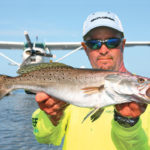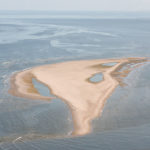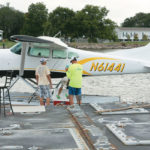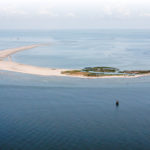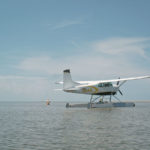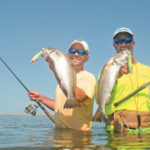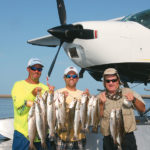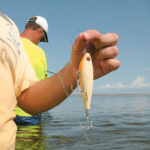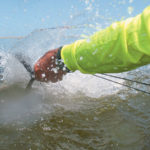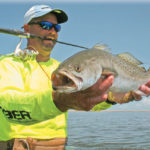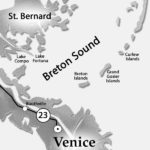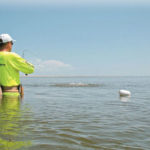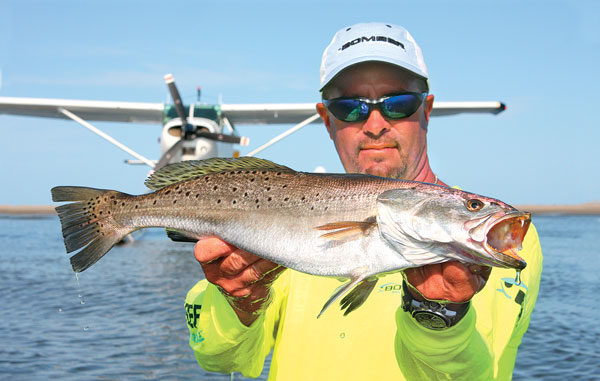
Resurgent Grand Gosier Island once again a summer hotspot for speckled trout
It’s a 35-minute boat ride from Lafitte to Grand Gosier Island.
That is, of course, if your boat has wings.
For most of Capt. Theophile Bourgeois’ career as a full-time fishing guide, he’s been locked by gravity to places like The Pen, Bayou Dupont and Barataria Bay. The fishing’s always good there, and is sometimes downright fantastic, but like a Plains traveler, Bourgeois’ eyes have often drifted dreamily to new areas just outside his reach.
“I work shows all over the country,” Bourgeois said. “When people hear you’re from Louisiana, all they want to talk about are the Chandeleur Islands.”
That’s because the island chain on the far eastern edge of Louisiana’s territorial waters is like a magic mountain in a fantasy land. Anglers looking to “get away from it all” couldn’t ever hope to find a more isolated area, and still catch inshore species. There’s no cell service, and the mainland is invisible to the naked eye.
The Chandeleur chain was left behind like a wayward child when the Mississippi River abandoned the St. Bernard Delta in favor of its current course. It seems almost out of place, rising from the depths of the open Gulf, and holds its spindly crescent form despite absorbing body blows from recent tropical monsters.
Providing virtually the only cover and relief change for miles in any direction, this time of year the island chain hosts a super buffet of fish species. But it’s one in particular that draws Mississippi anglers on mother ships from Biloxi, weekend anglers from Venice and Bourgeois from Lafitte.
Speckled trout.
“The specks out there are big, and they’ve got lots of them,” Bourgeois said.
For the personable and entertaining guide, that makes it worth thumbing his nose at the Mississippi River levees as he crosses from the west bank to the east bank the only reasonable way he can think of — by plane.
Bourgeois has contracted with Southern Seaplanes to fly clients from his spacious Lafitte lodge to the alluring and exotic Chandeleur Island chain. The cost is incredibly reasonable, and for Louisiana anglers, the journey itself is worth the fee as they fly 1,500 feet over their favorite marsh spots and see them from a new perspective.
Sportsman contributor Chris Ginn and I look at each other, and exchange nervous grins. We’ve just loaded ourselves into the cozy confines of a Cessna 185 tied to Bourgeois’ dock, and put on headphones to dampen the roar of the single-engine prop.
Sitting forward of Ginn is Lyle Panepinto of Gretna, an experienced pilot who’s been flying since 1973. Next to him is Bourgeois, who’s been taking to the skies for six years and is at the tail end of his mandatory training period. He has the controls.
A light breeze is trickling in from the north, but a drawbridge over the Barataria Waterway prevents a takeoff into it.
“We’ll just take off to the south,” Panepinto says into his mouthpiece. “We shouldn’t have any trouble getting up.”
Bourgeois adjusts his flaps and rudders, and jacks up the throttle. The plane responds instantly, and races down the rippled bayou.
Within seconds, the Cessna seems eager to take flight, but Bourgeois holds it down until it’s built up enough speed. Then he gives the plane its head, and it leaps off the bayou.
There’s nary a shimmy or shake in the plane as it gains altitude, and Ginn and I stare out the windows slack-jawed.
Bourgeois begins a bank to the east, over The Pen, and the massive sprawl of Lake Salvador becomes visible to our north.
Bourgeois almost immediately radios the Belle Chasse Naval Air Station to alert them to our presence and planned destination — the Southern Seaplanes base in Belle Chasse to top off our fuel tanks.
Air-traffic control gives us clearance and informs us of a C-130 that’s in the process of taking off. We watch it from the air, and listen to much of the communication between the pilot and the tower.
The first flight of the day is 12 minutes long, but seems like 12 seconds. Bourgeois lands the craft on a canal adjacent to the Southern Seaplanes facility, and motors up a ramp to dry land and the fuel dock.
After a quick refueling, Bourgeois taxis to a narrow runway.
“The plane will jump off the runway,” Panepinto tells Ginn and me.
Sure enough, within seconds we’re airborne again, and crossing over the Mississippi River.
Panepinto points out the Caernarvon Freshwater Diversion and the Big Mar, and Ginn and I strain to see bass boats in Lake Lery.
To our left, we see Shell Beach, then Hopedale and the new rock dam across the decommissioned Mississippi River-Gulf Outlet.
We parallel the MRGO, flying over Lake Amadee, Lake Robin, Lake Fortuna and Mozambique Point.
At 1,500 feet, the air is much cooler than at ground level, and the temperature in the cabin is a comfy 75 degrees.
“Everybody wants to know if these planes have air-conditioning,” Panepinto says with a smile. “They do, but the Freon doesn’t kick in until October.”
Panepinto points out Stone Island to the south, and from this level, it becomes apparent that the island’s days are numbered. There’s virtually nothing left to it.
Ahead, two little anomalies on the horizon look even less impressive. Amidst the iron forest of rigs and wellheads, they look like toothpicks on the ocean.
“That’s Breton and Gosier,” Panepinto says. “From up here, they don’t look too big, do they?”
Certainly they don’t, but they both look much more impressive than they did a half decade ago. Breton was ripped to shreds by Hurricane Katrina, and Gosier was completely annihilated by the historic storm.
“Even three years ago, Gosier was entirely underwater,” Panepinto says.
Our first pass is over Breton, which has maintained its characteristic hook shape. Within the cove, a massive school of mullet is milling about, seeking shelter from the marauding predators that think mullet tastes like ribeye.
Bourgeois is tempted to put the plane down and fish for the trout that are surely on the edges of the mullet, but decides to venture the short distance up to Gosier to see what’s happening.
Upon arrival, it’s apparent that we couldn’t go wrong at either stop. Gosier is alive with activity, with seagulls in giant flocks diving down onto frenetic action below.
“Most of that is bluefish,” Panepinto says.
We continue on, and see stingrays peppering the shallows off the southern point and sorties of 6- to 8-foot sharks on the prowl for their next meals.
Sharks are part of the deal in surf fishing, but it’s one thing to assume they’re there. It’s quite another to see them and know they’re there.
Ginn looks at me wide-eyed.
“It looks like shark week on Discovery Channel down there,” he says.
No sharks, however, are apparent at the middle of the backside of the island, and that’s where Bourgeois decides to put the plane down. The seas are absolutely flat calm, and the amphibious skids touch down smoothly. We give Bourgeois scores on the landing, and he averages a 9 out of 10.
Before the plane has even come to a complete stop, Panepinto is out the door and fumbling for his rod. He’s been fishing the islands since the early 1970s, and loves it almost as much as he does flying.
Panepinto begins casting immediately, because the fish could truly be anywhere on the productive island.
In fact, during the morning’s trip to Grand Gosier to film a news spot with Don Dubuc, Panepinto caught a 6 1/2-pound trout on his second cast.
No such luck this afternoon.
But Panepinto moves rapidly toward the northern tip of the island, while Bourgeois and Ginn wander south.
I stay close to the plane, hooking a trout on one of my first 10 casts with a bone-colored Bomber Badonk-A-Donk but losing it during the retrieve. A few casts later, I get the first fish of the day, a 14-inch trout that will look better in the grease than on the stringer.
A few fruitless casts later, I hear Bourgeois and Ginn yelling to get my attention. They’ve located a school of fish that are smashing their topwaters on almost every cast.
I move as fast as I can in the waist-deep water, and arrive to watch Bourgeois hook another fish that goes absolutely bananas on the surface.
After he subdues it, he raises the stringer to show a dozen or so fish that average 3 pounds. These are no school trout.
I make a cast to get in on the action while Ginn retrieves the video camera from the plane. The fish treat our topwater Badonk-A-Donks with utter disdain, smashing and slapping them, jumping over them and propelling them off the surface.
Topwater action is always a blast.
Topwater action while surf fishing is what dreams are made of.
Topwater action while surf fishing and catching lunker trout is truly nirvana on earth.
We catch what we need for pictures, and leave them biting to return to the plane and let Ginn work his photographic magic.
With the sun getting lower in the sky, we load up and point the propeller west toward Lafitte. Along the way, without the need to stop in Belle Chasse for fuel, we fly directly over Oak River Bay, Ponton Bay, Bay Jack Nevette, Pointe Fienne and Lake Batola, all of which are my weekend stomping grounds.
I see ponds rimmed with grass with gin-clear water in the middle that I didn’t know existed. I make a mental note to introduce a gold spoon to them in days to come.
We cross the Mississippi River, and before we know it, Bourgeois is losing altitude and sizing up his landing into the Barataria Waterway in front of his lodge.
Ginn and I can only shake our heads.
Our trip to Grand Gosier was a taste of what Bourgeois is now offering clients. For $400 per person (minimum of three people), he’ll fly clients to the Chandeleur Islands or the islands of southern Plaquemines, Jefferson, Lafourche or Terrebonne parishes for a day’s surf fishing.
He also has another deal that includes afternoon surf fishing, lodging, three meals and a day’s boat fishing for $795 per person (minimum three people).
Visit www.neworleansfishing.com for more details.
Bourgeois picks which island chain to go to before the plane ever leaves the dock. If storms are pounding the Chandeleur chain, he’ll go south. Last Island, he said, is only 32 minutes from his lodge by plane.
On the day before our trip, Bourgeois took a quick trip to Last Island, and landed 35 trout on topwaters during the middle of the day.
There are inherent advantages to fishing from a plane, he said.
“The conventional way to fish Gosier is to come from Venice by boat,” Bourgeois said. “First you have to drive all the way to Venice, then you have to take your boat there. That’s at least 30 minutes one way by boat. So what if you get there and it’s all milked up? You’re committed at that point.
“But in the plane, we just do a 180 and head west.”
Also, from a plane Bourgeois can see things that just aren’t visible at boat level.
“(In a plane) you can see how the current’s moving, where the bait’s setting up and where the clean water is,” he said. “Once you see that, you know where to go once you’re on the water.”
Panepinto, who’s been flying to the islands for 40 years, said trout are never visible from the air, but baitfish, particularly mullet, are. Also, in the late summer and throughout the fall and winter, redfish move to the islands, and they’re plainly visible from the air.
“You just see where the fish are holding, and you fish there,” he said. “There’s nothing to it.”
Bourgeois feels like he’s blazing a trail into an uncharted style of Louisiana fishing.
“We’re trying to offer something that nobody’s doing,” he said. “Alaska has this type of thing, and it’s a big draw for them. Why not here in Louisiana, where our fishing is better than anywhere?”
I can’t think of any reason.
